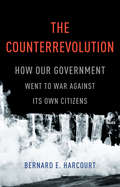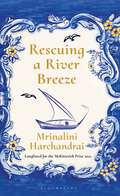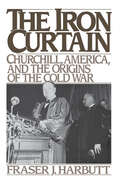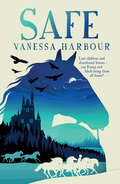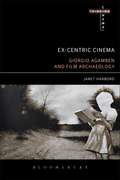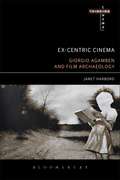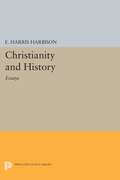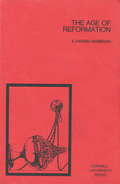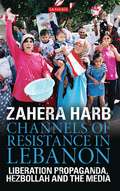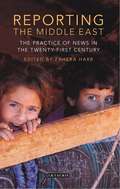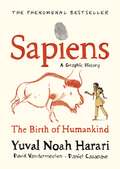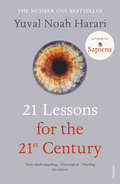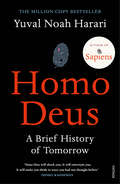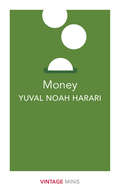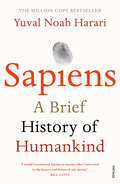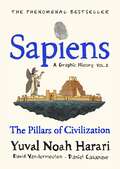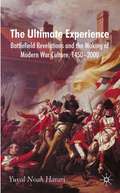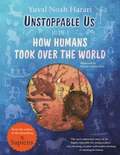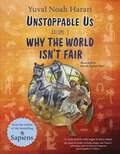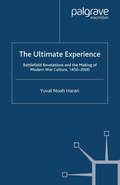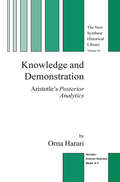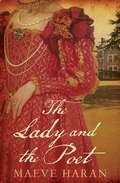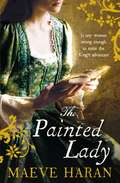- Table View
- List View
The Counterrevolution: How Our Government Went To War Against Its Own Citizens
by Bernard E. HarcourtMilitarized police officers with tanks and drones. Pervasive government surveillance and profiling. Social media that distract and track us. All of these, contends Bernard E. Harcourt, are facets of a new and radical governing paradigm in the United States -- one rooted in the modes of warfare originally developed to suppress anticolonial revolutions and, more recently, to prosecute the war on terror. The Counterrevolution is a penetrating and disturbing account of the rise of counterinsurgency, first as a military strategy but increasingly as a way of ruling ordinary Americans. Harcourt shows how counterinsurgency's principles -- bulk intelligence collection, ruthless targeting of minorities, pacifying propaganda -- have taken hold domestically despite the absence of any radical uprising. This counterrevolution against phantom enemies, he argues, is the tyranny of our age. Seeing it clearly is the first step to resisting it effectively.
Rescuing a River Breeze
by Mrinalini HarchandraiIt is 1961 and Goa is under Portuguese rule. In the heart of Panjim, life is as usual on the banks of the river Mandovi. Thirteen-year-old Shirly Quarachim's idyllic days include outings to her father's mines, convent school shenanigans and prep for an upcoming musical. She is also falling in love for the first time.But the drums of war are being readied. Indian forces amass across the border, while the Portuguese dictator António Salazar is determined to burn everything down before giving up Goa. When Shirly's beloved father is arrested on charges of treason, she must put her teenage reveries aside and face off against intimidating dhowmen, resistance fighters and a sadistic police officer who loves a bit of torture. Through this exquisite tale of a girl on the cusp of womanhood, Rescuing a River Breeze draws a vivid portrait of a bygone era and a people wrestling with identity and nationhood.
The Iron Curtain: Churchill, America, and the Origins of the Cold War
by Fraser J. HarbuttIt was forty-two years ago that Winston Churchill made his famous speech in Fulton, Missouri, in which he popularized the phrase "Iron Curtain." This speech, according to Fraser Harbutt, set forth the basic Western ideology of the coming East-West struggle. It was also a calculated move within, and a dramatic public definition of, the Truman administration's concurrent turn from accommodation to confrontation with the Soviet Union. It provoked a response from Stalin that goes far to explain the advent of the Cold War a few weeks later. This book is at once a fascinating biography of Winston Churchill as the leading protagonist of an Anglo-American political and military front against the Soviet Union and a penetrating re-examination of diplomatic relations between the United States, Great Britain, and the U.S.S.R. in the postwar years. Pointing out the Americocentric bias in most histories of this period, Harbutt shows that the Europeans played a more significant part in precipitating the Cold War than most people realize. He stresses that the same pattern of events that earlier led America belatedly into two world wars, namely the initial separation and then the sudden coming together of the European and American political arenas, appeared here as well. From the combination of biographical and structural approaches, a new historical landscape emerges. The United States appears at times to be the rather passive object of competing Soviet and British maneuvers. The turning point came with the crisis of early 1946, which here receives its fullest analysis to date, when the Truman administration in a systematic but carefully veiled and still widely misunderstood reorientation of policy (in which Churchill figured prominently) led the Soviet Union into the political confrontation that brought on the Cold War.
The Iron Curtain: Churchill, America, and the Origins of the Cold War
by Fraser J. HarbuttIt was forty-two years ago that Winston Churchill made his famous speech in Fulton, Missouri, in which he popularized the phrase "Iron Curtain." This speech, according to Fraser Harbutt, set forth the basic Western ideology of the coming East-West struggle. It was also a calculated move within, and a dramatic public definition of, the Truman administration's concurrent turn from accommodation to confrontation with the Soviet Union. It provoked a response from Stalin that goes far to explain the advent of the Cold War a few weeks later. This book is at once a fascinating biography of Winston Churchill as the leading protagonist of an Anglo-American political and military front against the Soviet Union and a penetrating re-examination of diplomatic relations between the United States, Great Britain, and the U.S.S.R. in the postwar years. Pointing out the Americocentric bias in most histories of this period, Harbutt shows that the Europeans played a more significant part in precipitating the Cold War than most people realize. He stresses that the same pattern of events that earlier led America belatedly into two world wars, namely the initial separation and then the sudden coming together of the European and American political arenas, appeared here as well. From the combination of biographical and structural approaches, a new historical landscape emerges. The United States appears at times to be the rather passive object of competing Soviet and British maneuvers. The turning point came with the crisis of early 1946, which here receives its fullest analysis to date, when the Truman administration in a systematic but carefully veiled and still widely misunderstood reorientation of policy (in which Churchill figured prominently) led the Soviet Union into the political confrontation that brought on the Cold War.
Safe
by Vanessa HarbourIn the chaotic last days of World War II, Jacob and Kizzy are tricked into a life or death journey. Far from home, they are attacked and only just escape. They hide in a seemingly deserted mansion, but they keep hearing strange noises... Investigating, they find it shelters not only forty abandoned horses but a small band of lost children, displaced by the war. With danger on every side, can Kizzy and Jakob keep them safe and get them all home?
Ex-centric Cinema: Giorgio Agamben and Film Archaeology (Thinking Cinema)
by Janet HarbordIn the beginning, cinema was an encounter between humans, images and machine technology, revealing a stream of staccato gestures, micrographic worlds, and landscapes seen from above and below. In this sense, cinema's potency was its ability to bring other, non-human modes of being into view, to forge an encounter between multiple realities that nonetheless co-exist. Yet the story of cinema became (through its institutionalization) one in which the human swiftly assumed centrality through the literary crafting of story, character and the expression of interiority. Ex-centric Cinema takes an archaeological approach to the study of cinema through the writings of philosopher Giorgio Agamben, arguing that whilst we have a century-long tradition of cinema, the possibility of what cinema may have become is not lost, but co-exists in the present as an unexcavated potential. The term given to this history is ex-centric cinema, describing a centre-less moving image culture where animals, children, ghosts and machines are privileged vectors, where film is always an incomplete project, and where audiences are a coming community of ephemeral connections and links. Discussing such filmmakers as Harun Farocki, the Lumiere Brothers, Guy Debord and Wong Kar-wai, Janet Harbord draws connections with Agamben to propose a radically different way of thinking about cinema.
Ex-centric Cinema: Giorgio Agamben and Film Archaeology (Thinking Cinema)
by Janet HarbordIn the beginning, cinema was an encounter between humans, images and machine technology, revealing a stream of staccato gestures, micrographic worlds, and landscapes seen from above and below. In this sense, cinema's potency was its ability to bring other, non-human modes of being into view, to forge an encounter between multiple realities that nonetheless co-exist. Yet the story of cinema became (through its institutionalization) one in which the human swiftly assumed centrality through the literary crafting of story, character and the expression of interiority. Ex-centric Cinema takes an archaeological approach to the study of cinema through the writings of philosopher Giorgio Agamben, arguing that whilst we have a century-long tradition of cinema, the possibility of what cinema may have become is not lost, but co-exists in the present as an unexcavated potential. The term given to this history is ex-centric cinema, describing a centre-less moving image culture where animals, children, ghosts and machines are privileged vectors, where film is always an incomplete project, and where audiences are a coming community of ephemeral connections and links. Discussing such filmmakers as Harun Farocki, the Lumiere Brothers, Guy Debord and Wong Kar-wai, Janet Harbord draws connections with Agamben to propose a radically different way of thinking about cinema.
Christianity and History: Essays (PDF)
by Elmore Harris HarbisonIn Part I of Christianity and History, the author asks whether the committed Christian should be more conscious than the uncommitted of some meaning in history. In answering this he offers a critique of Arnold Toynbee and makes some penetrating observations on the teaching of history. Part II is concerned with the author's special field-the Protestant Reformation and its origins. Calvinism, with its dynamic sense of the historical process, receives special treatment, and there is a brilliant essay on Machiavelli and Thomas More. Three of the essays included in this new book appear here for the first time.Originally published in 1964.The Princeton Legacy Library uses the latest print-on-demand technology to again make available previously out-of-print books from the distinguished backlist of Princeton University Press. These editions preserve the original texts of these important books while presenting them in durable paperback and hardcover editions. The goal of the Princeton Legacy Library is to vastly increase access to the rich scholarly heritage found in the thousands of books published by Princeton University Press since its founding in 1905.
The Age of Reformation (The Development of Western Civilization)
by E. Harris HarbisonIn The Age of Reformation, first published in 1955, E. Harris Harbison shows why sixteenth-century Europe was ripe for a catharsis. New political and social factors were at work—the growth of the middle classes, the monetary inflation resulting from an influx of gold from the New World, the invention of printing, the trend toward centralization of political power. Against these developments, Harbison places the church, nearly bankrupt because of the expense of defending the papal states, supporting an elaborate administrative organization and luxurious court, and financing the crusades. The Reformation, as he shows, was the result of "a long, slow shifting of social conditions and human values to which the church was not responding readily enough. The sheer inertia of an enormous and complex organization, the drag of powerful vested interests, the helplessness of individuals with intelligent schemes of reform—this is what strikes the historian in studying the church of the later Middle Ages."Martin Luther, a devout and forceful monk, sought only to cleanse the church of its abuses and return to the spiritual guidance of the Scriptures. But, as it turned out, western Christendom split into two camps—a division as stirring, as fearful, as portentous to the sixteenth-century world as any in Europe’s history. Offering an engaging and accessible introductory history of the Reformation, Harbison focuses on the age’s key individuals, institutions, and ideas while at the same time addressing the slower, less obvious tides of social and political change. A classic and long out-of-print synthesis of earlier generations of historical scholarship on the Reformation told with clarity and drama, this book concisely traces the outlines, interlocked and interwoven as they were, of the various phases that comprised the "Age of Reformation."
Channels of Resistance in Lebanon: Liberation Propaganda, Hezbollah and the Media
by Zahera HarbThe South Lebanon conflict saw two decades of sustained resistance by the Lebanese to the Israeli occupation. The Lebanese media's role in achieving liberation over this period is significant, through campaigns conducted to unify the Lebanese people against their foreign occupier and in support of the Lebanese resistance in South Lebanon. This book investigates the culture and performance of Lebanese journalism in this setting. It is a story about journalism told by a journalist who is also using tools of scholarship and research to narrate her story and the story of her fellow journalists. Zahera Harb is also presenting here an alternative interpretation of propaganda under conditions of foreign occupation and the struggle against that occupation. She identifies the characteristics of 'liberation propaganda' through the coverage and experience of the two Lebanese TV stations Tele Liban and Al Manar within the historical, cultural, organisational and religious contexts in which they operated, and how these elements shaped their professional practice and their news values.
Channels of Resistance in Lebanon: Liberation Propaganda, Hezbollah and the Media
by Zahera HarbThe South Lebanon conflict saw two decades of sustained resistance by the Lebanese to the Israeli occupation. The Lebanese media's role in achieving liberation over this period is significant, through campaigns conducted to unify the Lebanese people against their foreign occupier and in support of the Lebanese resistance in South Lebanon. This book investigates the culture and performance of Lebanese journalism in this setting. It is a story about journalism told by a journalist who is also using tools of scholarship and research to narrate her story and the story of her fellow journalists. Zahera Harb is also presenting here an alternative interpretation of propaganda under conditions of foreign occupation and the struggle against that occupation. She identifies the characteristics of 'liberation propaganda' through the coverage and experience of the two Lebanese TV stations Tele Liban and Al Manar within the historical, cultural, organisational and religious contexts in which they operated, and how these elements shaped their professional practice and their news values.
Reporting the Middle East: The Practice of News in the Twenty-First Century (International Media and Journalism Studies)
by Zahera HarbHow do the media cover the Middle East? Through a country-by-country approach, this book provides detailed analysis of the complexities of reporting from the Arab World. Each chapter provides an overview of a country, including the political context, relationships to international politics and the key elements relating to the place as covered in Western media. The authors explore how the media can be used to serve particular political agendas on both a regional and international level. They also consider the changes to the media landscape following the growth of digital and social media, showing how access to the media is no longer restricted to state or elite actors. By studying coverage of the Middle East from a whole range of news providers, this book shows how news formats and practices may be defined and shaped differently by different nations. It will be essential reading for scholars and practitioners of journalism, especially those focusing on the Arab World.
Sapiens Graphic Novel: Volume 1
by Yuval Noah Harari David VandermeulenThe first volume of the graphic adaptation of Yuval Noah Harari's global phenomenon and smash Sunday Times #1 bestseller, with gorgeous full-colour illustrations and a beautiful package - the perfect gift for the curious beings in your life.One hundred thousand years ago, at least six different species of humans inhabited Earth. Yet today there is only one-homo sapiens. What happened to the others? And what may happen to us?In this first volume of the full-colour illustrated adaptation of his groundbreaking book, renowned historian Yuval Harari tells the story of humankind's creation and evolution, exploring the ways in which biology and history have defined us and enhanced our understanding of what it means to be "human". From examining the role evolving humans have played in the global ecosystem to charting the rise of empires, Sapiens challenges us to reconsider accepted beliefs, connect past developments with contemporary concerns, and view specific events within the context of larger ideas. Featuring 256 pages of full-colour illustrations and easy-to-understand text covering the first part of the full-length original edition, this adaptation of the mind-expanding book furthers the ongoing conversation as it introduces Harari's ideas to a wider new readership.
21 Lessons for the 21st Century: Ren Lei Ming Yun Da Yi Ti = 21 Lessons For The 21st Century
by Yuval Noah Harari**FROM THE AUTHOR OF THE MULTI-MILLION COPY BESTSELLER SAPIENS**Sapiens showed us where we came from. Homo Deus looked to the future. 21 Lessons for the 21st Century explores the present. How can we protect ourselves from nuclear war, ecological cataclysms and technological disruptions? What can we do about the epidemic of fake news or the threat of terrorism? What should we teach our children? Yuval Noah Harari takes us on a thrilling journey through today’s most urgent issues. The golden thread running through his exhilarating new book is the challenge of maintaining our collective and individual focus in the face of constant and disorienting change. Are we still capable of understanding the world we have created?
Homo Deus: A Brief History of Tomorrow
by Yuval Noah Harari**From the author of the phenomenal multi-million copy bestseller Sapiens****The Sunday Times #1 bestseller**WAR IS OBSOLETEYou are more likely to commit suicide than be killed in conflictFAMINE IS DISAPPEARINGYou are at more risk of obesity than starvationDEATH IS JUST A TECHNICAL PROBLEMEquality is out, but immortality is inWHAT DOES OUR FUTURE HOLD?
Money: Vintage Minis (Vintage Minis)
by Yuval Noah HarariSelected from the books Sapiens and Homo Deus by Yuval Noah HarariHow did money come to be invented? Why does it now have such significance in our lives? Does it make us happier or unhappier? And what does the future hold for it? With brilliant clarity and insight, Yuval Noah Harari takes the reader on a journey from the very first coins through to 21st century economics and shows us how we are all on the brink of a revolution, whether we like it or not. VINTAGE MINIS: GREAT MINDS. BIG IDEAS. LITTLE BOOKS.A series of short books by the world’s greatest writers on the experiences that make us humanAlso in the Vintage Minis series:Home by Salman RushdieBabies by Anne EnrightEating by Nigella LawsonDrinking by John Cheever
Sapiens: A Brief History of Humankind (Patterns Of Life Ser.)
by Yuval Noah Harari**Over 2 million copies sold****The Sunday Times #1 bestseller**FIRE gave us powerFARMING made us hungry for moreMONEY gave us purposeSCIENCE made us deadlyThis is the thrilling account of our extraordinary history – from insignificant apes to rulers of the world.
Sapiens A Graphic History, Volume 2: The Pillars of Civilization
by Yuval Noah HarariThe second volume of an epic, beautifully illustrated graphic history of humankind, based on Yuval Noah Harari's internationally bestselling phenomenonWhen nomadic Homo sapiens settled to live in one place, they started working harder and harder. But why didn't they get a better life in return?In The Pillars of Civilization, Yuval Noah Harari and his companions including Prof. Saraswati and Dr. Fiction travel the length and breadth of human history to investigate how the Agricultural Revolution changed society forever. Discover how wheat took over the world, how war, famine, disease and inequality became a part of the human condition, and why we might only have ourselves to blame.The origins of modern farming are told through Elizabethan tragedy, the changing fortunes of domesticated plants and animals are tracked in the columns of the Daily Business News, and the history of inequality is revealed in a superhero detective story.A radical, witty and colourful retelling of the story of humankind, adapted from Yuval Noah Harari's Sapiens: A Brief History of Humankind, Volume 2 can be read as a standalone or as a follow-up to Volume 1, The Birth of Humankind.Praise for Yuval Noah Harari's Sapiens: A Brief History of Humankind:'I would recommend Sapiens to anyone who's interested in the history and future of our species.' - Bill Gates'Interesting and provocative... It gives you a sense of how briefly we've been on this Earth' - Barack Obama'Jaw-dropping from the first word to the last... It may be the best book I've ever read' - Chris Evans'Contains a remarkable piece of information on almost every page and reminds us that we should be grateful to be human.' - Matt Haig'Sweeps the cobwebs out of your brain... Radiates power and clarity, making the world strange and new' - Sunday Times'Provocative and fascinating and opinionated...it makes the familiar seem unfamiliar. It altered how I view our species and our world.' - Guardian
The Ultimate Experience: Battlefield Revelations And The Making Of Modern War Culture, 1450-2000 (PDF)
by Yuval Noah HarariFor millennia, war was viewed as a supreme test. In the period 1750-1850 war became much more than a test: it became a secular revelation. This new understanding of war as revelation completely transformed Western war culture, revolutionizing politics, the personal experience of war, the status of common soldiers, and the tenets of military theory.
Unstoppable Us, Volume 1: How Humans Took Over the World, from the author of the multi-million bestselling Sapiens (Unstoppable Us #1)
by Yuval Noah Harari*From the author of the multi-million bestselling Sapiens comes an incredible new story of the human race, for younger readers.*We humans aren't strong like lions, we don't swim as well as dolphins, and we definitely don't have wings! So how did we end up ruling the world?The answer to that is one of the strangest tales you'll ever hear. And it's a true story . . .Have you ever wondered how we got here? From hunting mammoths, to flying to the moon?It is because we are unstoppable. But what made us so? Well, we have the most amazing superpower: the ability to tell stories. Fairy tales have led us from imagining ghosts and spirits to being able to create money (yes, really!).And this has made us very powerful . . . but very deadly. Nothing stands in our way, and we always want more.So get ready for the most amazing story there ever was - the incredible true tale of the Unstoppables. Find out how fire shrank our stomachs, how our ancestors spoke to animals, what football can tell us about being human, how we used our superpower for good and bad . . . and how YOU have the superpower to change the world.With full-colour illustrations showing the relentless rise and rise of the human race, this is history like you've never experienced it before.
Unstoppable Us Volume 2: Why the World Isn't Fair (Unstoppable Us #2)
by Yuval Noah Harari*From the author of the multi-million bestselling Sapiens comes the next volume in the incredible story of the human race, for younger readers.*Something really strange happened 10,000 years ago, and it changed everything.Why did millions of people agree to obey a few leaders? Where did kings and kingdoms come from? The answer to that is one of the strangest tales you'll ever hear. And it's a true story. Have you ever wondered how we got here? From gathering berries and hunting mammoths, to shopping at supermarkets and letting people tell us what to do?You might hear a lot of people say 'the world isn't fair'. But why isn't it? And how did it become so?In Unstoppable Us: Volume 1, we learned how humans told stories to become rulers of the world - for good and bad. Now, in this next chapter of the incredible true tale of the Unstoppables, find out how we learned to control animals like dogs, chicken and cows . . .And how a handful of humans learned to control everyone else.With full-colour illustrations showing the relentless rise and rise of the human race, this is history like you've never experienced it before.
The Ultimate Experience: Battlefield Revelations and the Making of Modern War Culture, 1450-2000
by Y. HarariFor millennia, war was viewed as a supreme test. In the period 1750-1850 war became much more than a test: it became a secular revelation. This new understanding of war as revelation completely transformed Western war culture, revolutionizing politics, the personal experience of war, the status of common soldiers, and the tenets of military theory.
Knowledge and Demonstration: Aristotle’s Posterior Analytics (The New Synthese Historical Library #56)
by Orna HarariThis study explores the theoretical relationship between Aristotle’s theory of syllogism and his conception of demonstrative knowledge. More specifically, I consider why Aristotle’s theory of demonstration presupposes his theory of syllogism. In reconsidering the relationship between Aristotle’s two Analytics, I modify this widely discussed question. The problem of the relationship between Aristotle’s logic and his theory of proof is commonly approached from the standpoint of whether the theory of demonstration presupposes the theory of syllogism. By contrast, I assume the theoretical relationship between these two theories from the start. This assumption is based on much explicit textual evidence indicating that Aristotle considers the theory of demonstration a branch of the theory of syllogism. I see no textual reasons for doubting the theoretical relationship between Aristotle’s two Analytics so I attempt to uncover here the common theoretical assumptions that relate the syllogistic form of reasoning to the cognitive state (i. e. , knowledge), which is attained through syllogistic inferences. This modification of the traditional approach reflects the wider objective of this essay. Unlike the traditional interpretation, which views the Posterior Analytics in light of scientific practice, this study aims to lay the foundation for a comprehensive interpretation of the Posterior Analytics, considering this work from a metaphysical perspective. One of my major assertions is that Aristotle’s conception of substance is essential for a grasp of his theory of demonstration in general, and of the role of syllogistic logic in particular.
The Lady and the Poet
by Maeve HaranAnn More and her four sisters have been brought up in the beautiful country house of Loseley, near Guildford in Surrey, by their grandparents, Sir William and the Lady Margaret More. Their only brother, Robert, lives with his pompous father and shrewish step-mother nearby. But though the sisters are close, it is Ann who is the most unusual in character. Wilful, argumentative, challenging and fiery, she is handsome rather than beautiful, and has an indomitable spirit. It is this that endears her to her grandfather, who encourages her learning and lets her loose in his well-stocked library to browse the volumes of Latin and Greek. Once her favourite sister Bett is married, Ann is sent to live in York House in London, where her uncle is Lord Keeper of the Seal. Ann knows her father is endeavouring to find her a match in marriage, and she is to be presented at the Court of Queen Elizabeth yet the journey past Nonsuch Palace, through Southwark, the city gates spiked with the heads of recent traitors and across the shining river proves unimaginably exciting. Soon, Ann is quite at home at York House, and there, in the company of her young cousin, she meets the poet John Donne, a man older and wiser than her, whose verse and character she just cannot resist. Rich in period detail, vivid in description and character, THE LADY AND THE POET is an utterly irresistible, compelling historical novel. It is, above all, the passionate story of the love match between one of the most famous poets of all time, and his young bride.
The Painted Lady
by Maeve Haran‘This is my tale and I will leave you to tell whether it be high romance or tragedy.’ Sixteen-year-old Frances Stuart arrives at the Restoration court to find her innocence and beauty are highly-prized commodities, envied by the women and desired by the men. Before long, King Charles II falls passionately in love with her and will stop at nothing to make her his mistress. But Frances is no conventional court beauty. She is determined to make her own choices in life, and to be with the man she loves. Can she overcome the dangerous pitfalls of the King’s obsession, the Queen’s jealousy, and the traps set for her by the King’s notorious mistresses, and make the life she wants for herself? Set against the drama of the Great Plague and the Fire of London, The Painted Lady brings to life the vibrant and decadent court of Charles II and in Frances Stuart discovers a passionate young woman prepared to fight for her own destiny. Praise for Maeve Haran’s The Lady and the Poet ‘This is history as pure entertainment, an inventive and delicious feast of passion, wit and intrigue.’ The Times ‘With its fascinating insight into Tudor life, this will absorb you to the end’ She ‘The clothes, the jewels, the smell of the place are all evoked; and everyone from the Queen herself to the elusive, sexy figure of Donne come wonderfully to life’ A. N. Wilson, Readers’ Digest
